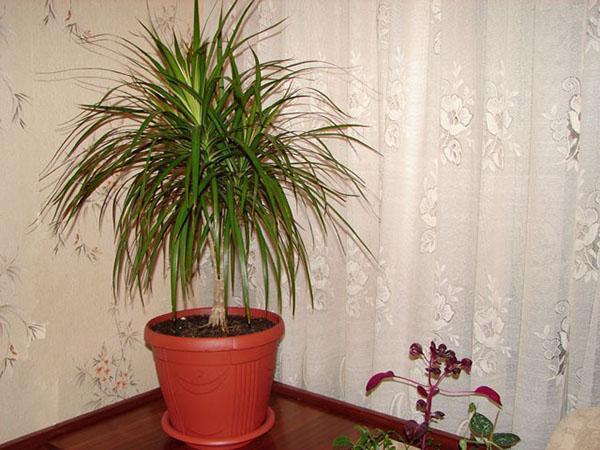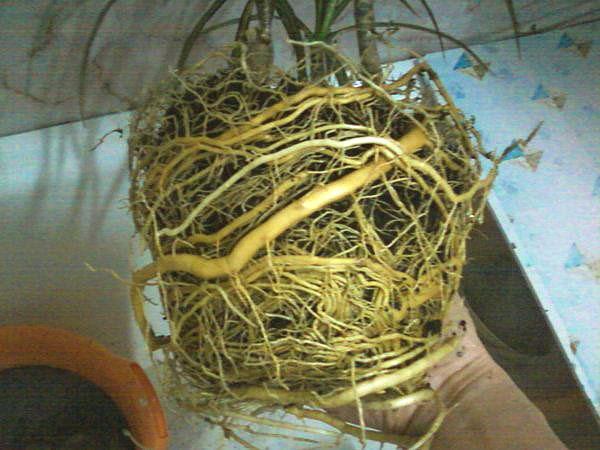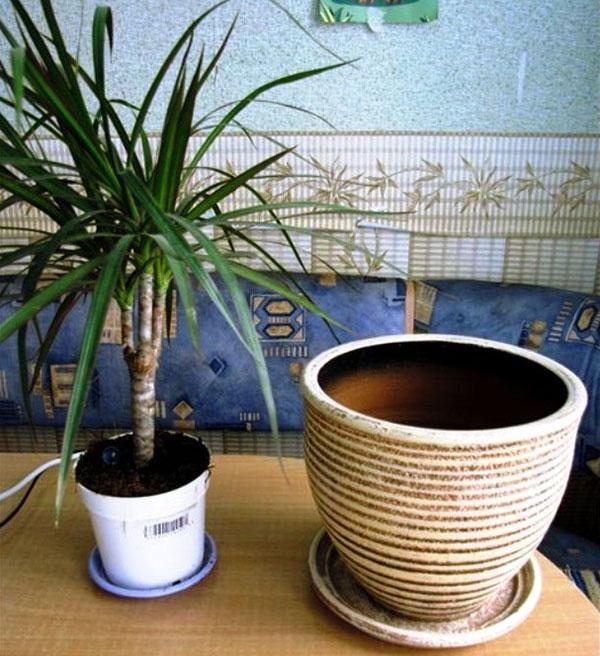Does your dracaena need a transplant? Do it right
 Dracaena, like a houseplant, lives for a long time at home. It grows, the root system develops, and the dishes become cramped, there is not enough food. To correctly transplant dracaena, traumatizing the roots as little as possible, will help the knowledge of basic techniques.
Dracaena, like a houseplant, lives for a long time at home. It grows, the root system develops, and the dishes become cramped, there is not enough food. To correctly transplant dracaena, traumatizing the roots as little as possible, will help the knowledge of basic techniques.
When a flower transplant is needed

- A dracaena transplant is required if a store-bought plant is in transport soil. Usually these flowers are delivered from Holland. If the container is spacious enough and the flower is grown on local farms, you can not rush to transplant.
- The plant has grown, and the roots do not fit in the pot, they go out into the drainage holes.
- Dracaena has stopped growing, yellow leaves have appeared, is in one pot for more than the recommended period.
- There are signs of overflow, root decay, or deterioration in the quality of the substrate.
- Fly larvae and pests have appeared in the soil.
If the plant is in a satisfactory condition, then the transplant is carried out in the spring, when tissue regeneration is best. In critical cases, the transplant is carried out at any time of the year.
How to properly transplant dracaena at home
 In order to properly change the container, a number of conditions must be met. So, the size of the pot should match the growth of the dracaena. If the stem has grown to 40 cm, a pots with a diameter of 15 - 20 cm in the shape of a glass will be just right. Each next transplant requires a capacity of 6 cm more, so that 3 cm remains from the wall to the clod of earth with roots.When the plant becomes so large that changing the tub becomes a problem, it is necessary to remove the top layer of the earth as deep as possible.
In order to properly change the container, a number of conditions must be met. So, the size of the pot should match the growth of the dracaena. If the stem has grown to 40 cm, a pots with a diameter of 15 - 20 cm in the shape of a glass will be just right. Each next transplant requires a capacity of 6 cm more, so that 3 cm remains from the wall to the clod of earth with roots.When the plant becomes so large that changing the tub becomes a problem, it is necessary to remove the top layer of the earth as deep as possible.
 The survival rate of a plant and its further development depends on:
The survival rate of a plant and its further development depends on:
- the correct composition of the soil mixture;
- fulfillment of hygiene requirements during transplantation;
- providing conditions for the restoration of roots after transplantation.
You can make the composition of the substrate yourself or buy a ready-made mixture for palm trees. It is believed that the purchased land contains all the necessary supplements in the form of trace elements. Any mixture must be sterilized before placing it in a container. The composition of the substrate prepared at home:
- sod land -2 parts;
- peat - 1 part;
- leaf land - 2 parts;
- compost - 1 part.
The addition of vermiculite and crushed birch coal to the substrate is encouraged. You can add some ceramic chips - crushed red brick. Expanded clay, pebbles, and broken glass are used for the drainage layer. It is impossible to reuse expanded clay, it absorbs harmful salts.
Tap water is treated with chemicals. For watering indoor plants, you can use settled softened water with the addition of activated carbon. It is best not to use rain or snow water in urban pollution.
 The transplant container can be made of any material.A prerequisite is the presence of drainage holes and its stability, that is, a small taper of the glass. The container must be washed with hot water and laundry soap.
The transplant container can be made of any material.A prerequisite is the presence of drainage holes and its stability, that is, a small taper of the glass. The container must be washed with hot water and laundry soap.
The instruments used for transplanting - secateurs, scissors must be clean. Water for irrigation is used soft, settled.
How to transplant dracaena at home, video:
As you can see from the video tutorial, the work must be done carefully, preserving the root system as much as possible. This is especially important when the plant has already been placed in a container and it is necessary to carefully compact the soil around it. The lesson shows in detail how to transplant dracaena after purchase. Just as carefully, straightening the roots, cuttings and the top of the dracaena are planted, if the young plant is propagated at home.
 More often an adult plant has to be transplanted. If a healthy dracaena is transplanted, which needs additional volume, transshipment is done. In order to remove the lump from the container without destruction, it is necessary to dry the soil for 2 days. Then the lump should be tucked a little and the plant will easily come out when tilted, keeping its shape.
More often an adult plant has to be transplanted. If a healthy dracaena is transplanted, which needs additional volume, transshipment is done. In order to remove the lump from the container without destruction, it is necessary to dry the soil for 2 days. Then the lump should be tucked a little and the plant will easily come out when tilted, keeping its shape.
 In an already prepared vessel with a drainage layer and sprinkled with earth, a removed flower is installed in the center and sprinkled with earth from all sides with compaction. At the end, the plant needs to be watered abundantly, because before transplanting it was slightly dried. After that, create gentle conditions for the restoration of the root system. For two weeks the plant is kept in moderate light and a temperature of 20-22 degrees.
In an already prepared vessel with a drainage layer and sprinkled with earth, a removed flower is installed in the center and sprinkled with earth from all sides with compaction. At the end, the plant needs to be watered abundantly, because before transplanting it was slightly dried. After that, create gentle conditions for the restoration of the root system. For two weeks the plant is kept in moderate light and a temperature of 20-22 degrees.
How to transplant dracaena into another pot with a revision of the root system?
If a lump of earth is densely entwined with roots, it will be necessary to remove some of them during transplantation. The root grows quickly and will restore efficiency in a few days. Therefore, the roots are straightened and the lower part is removed with scissors or pruning shears.
In a new container, it is important that the root collar of the adult plant remains at the same level. Therefore, the ground under the roots is regulated, the roots are spread over the surface and the substrate is carefully poured, slightly compacting so as not to break off the roots. When the pot is full, the new plant is watered. From above, so that there is no evaporation, a layer of expanded clay can be laid. But check the dryness of the soil only under it, so as not to overflow.
 If the plant is poured, and root decay is possible, transplanting dracaena at home is carried out with cutting off the diseased parts. Slices should be sprinkled with crushed coal. For a sick plant, create the best conditions for survival. But you need to know that the main reason for poor survival is overfilling. A weak root system at the time of transplanting easily rots.
If the plant is poured, and root decay is possible, transplanting dracaena at home is carried out with cutting off the diseased parts. Slices should be sprinkled with crushed coal. For a sick plant, create the best conditions for survival. But you need to know that the main reason for poor survival is overfilling. A weak root system at the time of transplanting easily rots.
Florist errors when transplanting dracaena
 Usually, the transplant procedure is painless and the plant does well. On the forums, complaints about plants dying after transplantation are found. All recommendations for soil preparation must be followed. You cannot take a pot "for growth." The soil, in which the roots do not work, turns sour and poisons the plant. In addition, moisture accumulates in the stagnant zone, and putrefactive processes are provoked. The plant is sick from the overflow, and the owner is watering it again, trying to revive it.
Usually, the transplant procedure is painless and the plant does well. On the forums, complaints about plants dying after transplantation are found. All recommendations for soil preparation must be followed. You cannot take a pot "for growth." The soil, in which the roots do not work, turns sour and poisons the plant. In addition, moisture accumulates in the stagnant zone, and putrefactive processes are provoked. The plant is sick from the overflow, and the owner is watering it again, trying to revive it.
The first two weeks after transplantation, dracaena should be treated like a baby. You do not need to bother her, create good conditions, eliminate drafts, and you will succeed.